Breachworld by EverettLO
Overview
Original SA post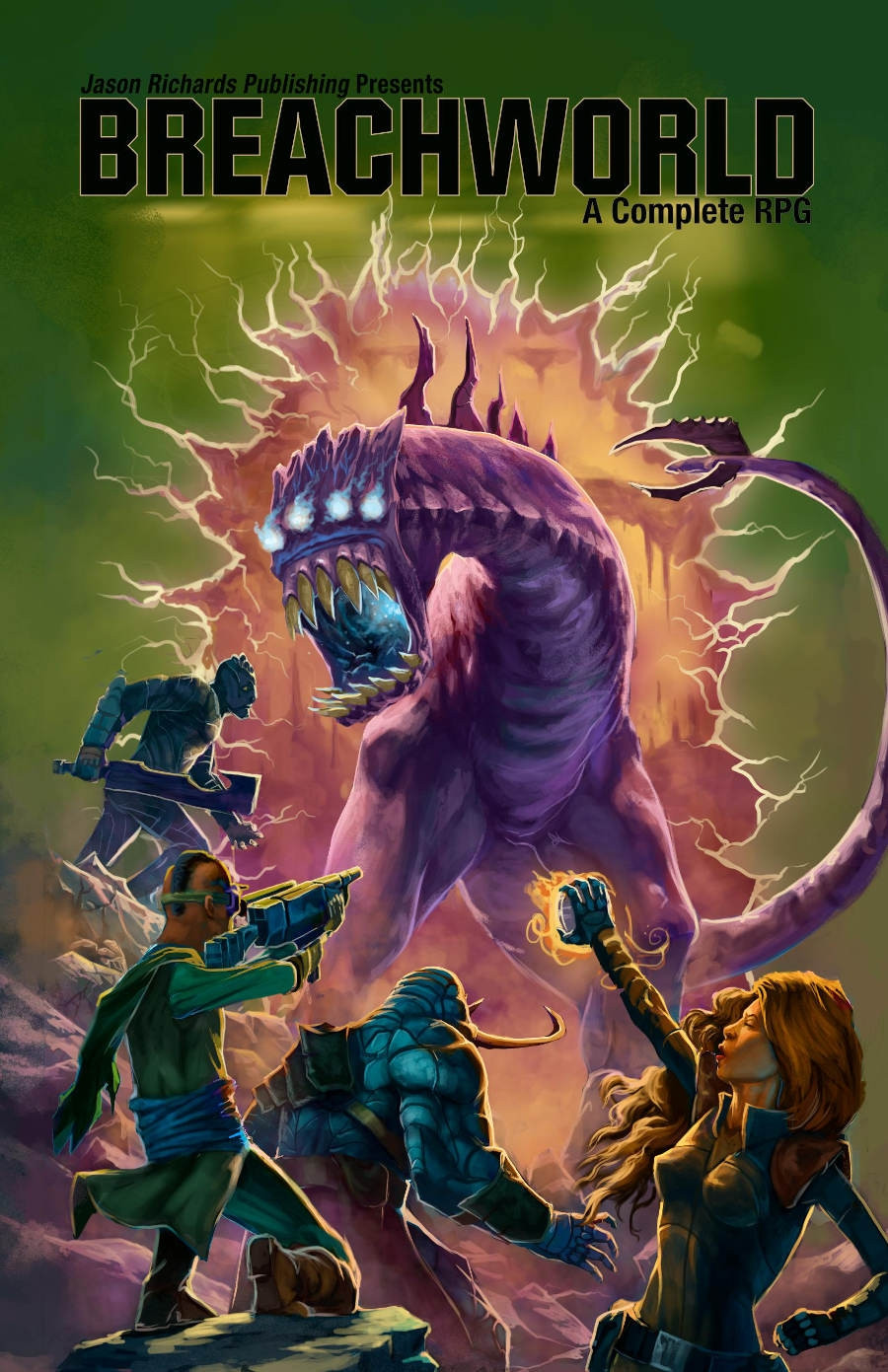
Breachworld Part 1: Overview
That picture is the cover of the Breachworld book, and it pretty well encapsulates everything that the game promises: monsters, magic and science fiction thrown together in a single setting. A more cynical or straightforward person would describe it as Rifts and nothing more.
Someone in the Kickstarter thread requested a F&F review of this game. In short, Breachworld is a pared down pastiche of Rifts that uses the Micro D6 engine. I think I backed the game because there was a big quote on the KS page by Kevin Siembieda saying positive things about the author. For someone as notorious as Siembieda to praise the author of a project so obviously similar to Rifts caught my attention. That, and the fact that a version of Rifts with sensible mechanics is something that every Rifts player in the past 20 years has been gunning for. I probably figured throwing in $30 on the odds it lived up to the possibility was a decent bet.
I apologize up front but a lot of this review will be comparing the game to Rifts. There’s just no getting around it.
Breachworld was put up on Kickstarter last year by Jason Richards, who I have come to find out was actually a former (and possibly current) freelancer for Palladium. The ‘current’ part, if accurate, probably explains the nice comments from Siembieda. Richards is listed as having written some Chaos Earth stuff, some of the later Rifts world books, and was one of the long term editors of The Rifter. I’d almost call this game his own Rifts Heartbreaker, but it doesn’t quite fit the definition since the author is established in the industry and seems to have a decent grasp of RPG trends.
Like a lot of people who started out gaming in the early 1990s, I played a fair amount of Rifts until maybe 1999 or 2000. I still have good memories of playing even if the game I played only had a passing resemblance to the game as written. Palladium’s policy of cracking down on conversions seems to have left a strange vacuum where you would expect to find dozens of conversions to all sorts of systems. Some do exist, but they are few and far between.
In interviews the author seems aware of how similar his project is to Rifts. He maintains that there are two distinct differences: that his game is intended for smaller scale stories and that he has included a distinct goal for the players to achieve. The first difference is questionable to me. If we compared this game to the Rifts corebook alone, you’d probably find a similar scale. Both are mostly at the human level and the actions of kingdoms are useful only as a backdrop. As Rifts developed, the scale grew as the power creeped until it became the monster you find today. I suspect if Breachworld continues to develop, the same problems could occur without careful maintenance of the line.
The second difference is a bit more concrete. It appears your characters are intended to crusade against the breaches using a new technology that has been developed to close them. I’d be curious to see how many people actually stick to the plan, though. Part of the appeal of a gonzo post apocalyptic setting is the sheer freedom of possibility. In the couple of times I played Gamma World, we tended to get caught in things tangential to the plot the GM was trying to push. There is just too much to do and too much to see to keep on such a narrow path, and I doubt this game will manage it any better.
This is not a big game. The PDF clocks in at 214 pages, about half of which is rules and character creation and the other half is everything else. The physical book that came from the KS is very solid. It is about the size of the FATE Core book and has the cover image seen at the beginning of this post. It’s hardcover, full color on decent paper, and has a fair amount of art. It definitely shows that the author is experienced in the publishing game.
I expect this will be wrapped up in two or three more posts. Next will be a brief setting overview and character creation.
Overview and Characters
Original SA post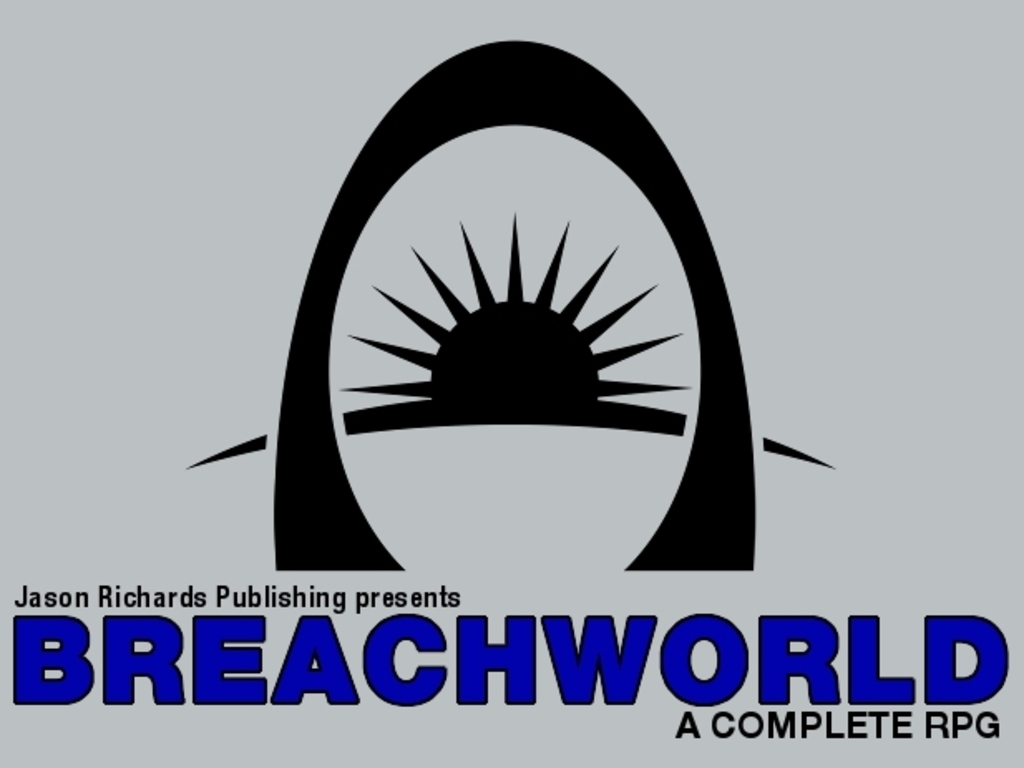
Breachworld Part 2: Overview and Characters
The first thing in the book besides contents and a thanks to the backers is a two page synopsis of the Breachworld setting. It’s just a snapshot to help you understand the world your characters will be operating in, and is backed up by a larger description of the world after all of the rules have been laid out.
At some point in the past, humanity was in a Golden Age where the use of a piece of technology called a ‘breach’ was commonplace and allowed people to travel from one point on Earth to another instantaneously. Predictably, the technology was flawed and eventually the breaches catastrophically changed from a single path between two points to each breach becoming a one way door from another dimension.
Creatures from thousands of other universes suddenly poured into Earth and became trapped in our world. Some were sentient, some were monsters, and some were more like plant life or insects. The sudden influx caused the total collapse of human society. Now, likely hundreds of years later, people have coalesced into different societies. Some are remnants of the old human world, with high technology at their disposal and reclamation of Earth on their mind. Some are more tribal and mix freely with the aliens from the breaches. Some are just plain alien and based on the strange societies of refugees from other dimensions.
Monsters are everywhere and some people seem to have developed powers that defy common explanation. Most importantly, a group of scientists and engineers called The Collective has recently managed to piece together a device that can close breaches. They’ve now begun the long process of sealing off Earth’s dimensional borders.
That’s the three paragraph recap of a two page preview. There’s more detail to this story later. In fact, some of the detailed explanation of how breaches work leads to unintentional comedy or perhaps a slow, hopeless apocalypse spread across thousands of worlds. That’s a story for another post, though.
From there we move through a very brief “What is Role Playing?” spiel and on into building your character. Character creation is very much of the old school variety, which is probably obvious since it’s based off an engine popularized in the mid-1980s. The rules are actually explained in a later chapter, so some of the particulars of what is happening will probably be lost on a reader unfamiliar with D6. I haven’t played a D6 game in nearly 20 years so it took awhile to get into the swing of things. The Micro D6 engine seems slightly different than what I recall of the revised edition of West End’s Star Wars. It actually seems quite a bit better. For instance, it appears harder to create a Wookie that can dance naked in a barrage of heavy blaster fire in this system, although it isn’t totally impossible.
As a rule, D6 is typically classless. Theoretically you come up with a character concept then spend your stat and skill points to make a reasonable facsimile if how that character would appear mechanically. In reality, I’d imagine a lot of people spend their points on what appears interesting and then work backwards to create a character to explain the spread. I don’t recall Star Wars having your race factor into how many points you get to spend, but rather as a minimum or maximum to individual stats. I could be wrong, though.. If it is a new thing, this game actually attaches a lot more power to the choice of race than Star Wars. I guess that’s fitting for a Rifts clone.
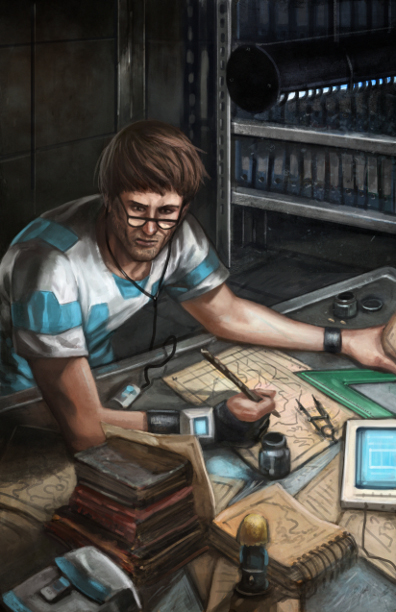
Rogue Scholar is still an interesting character concept that no one will play.
The first step is to consider your four stats. Each has racial minimums and maximums and each race has a different amount of points to spend. They are:
Might – physical strength and toughness
Agility – “aim and coordination”
Wit – intelligence
Charm – personal charisma and willpower, which is a strange pairing
For humans, you have 12D of points to spend on stats. They can vary between 1D and 4D. The D you spread around in your stats represents six sided dice that you roll when the situation calls for it. The more dice you can roll the better the outcome is likely to be.
After your stats we have a brief, "optional" aside about classes. I don't know how optional it really is, though, since without it there is no magic or psionics in a setting where that's a major selling point.
As said, game is generally classless unless you happen to meet certain prerequisites. If you do, you can take an ‘Advanced Class’ which gives you access to powers that other people can’t use. At this time the only Advanced Class is the Epic, which is another name for mage or psychic. It’s someone who can manipulate the Aether that pours through some breaches and allows for otherwise impossible feats. The book follows it up with a list (and only a list) of the many powers an Epic can potentially use. The powers have Palladium-esque, weirdly clinical category names such as Biochemical Manipulation of Space-Time Manipulation.
The author mentions that another advanced class still pending will be the Fighter, who has a list of combat maneuvers comparable to the spell list available to the Epic. I will be curious to see if the fighter turns out to be similar in power level to the Epic or if we’re just seen the introduction of the wizard dominant paradigm to a classless system.
Next we have skills and perks. Skills are tied to a stat and only go up to 2D at character creation. They add directly to the stat in question when called for. For instance, if you are trying to punch someone, you add your Might stat to your Brawl skill and roll that many dice to hit. Humans have 7D to divide among their 40 potential skills. Since you also use your skill dice to spend on perks, it seems like skills are really only useful to shore up deficient stats. To put it another way, your stats are going to be a lot more important than your skills. You can also list a skill as ‘specialized’ which makes it fit a very specific situation (the given example is ‘climbing’ versus the more generalized ‘athletics’) but provides 3D of benefit for 1D of cost.
Perks and complications are the last important thing before we get into races. They work like advantages and disadvantages do in most classless systems. You pay for them using the same pool of dice available to skills and can gain benefits from armored skin to inexplicable luck to a signature weapon. Complications are the opposite and provide extra dice to spend on skills and perks. Maybe your hero is allergic to cats, is illiterate, or just plain cursed by the gods of fate.
A last note is to equip your character. For a Rifts-like game, this step is awfully freeform. You just take whatever you think your character would reasonably have and haggle with the GM if there’s something that might not be reasonable. It's hard to say if it's a liberating approach or a lazy one. Either way, it's probably what I would have ended up doing even without their suggestion.
Since this post is actually a lot longer than I intended, I will break off races into another post and kiss that optimistic idea of getting this done is four posts goodbye.
PS This is the actual, positive quote from Siembieda on the Kickstarter:
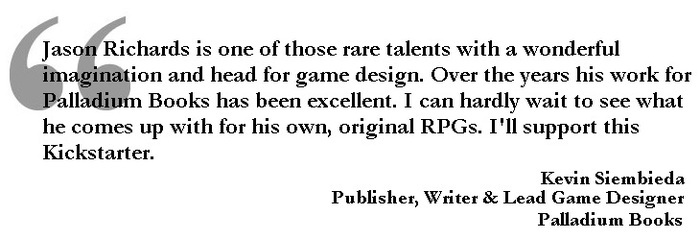
Rereading it, I could see it being a catty dig at Jason Richards, but I honestly can't see Siembieda pulling something quite so bitchy and subtle.
Character Races
Original SA post
Breachworld Part 3
Now we move into races, which is probably the most significant choice you make in character creation. It determines the allowed range for you stats, how many points you get to improve them, and how many points you get to spend on skills and perks. In interviews, the author has mentioned that he does not consider balance between characters to be a necessary design goal. I don’t agree with that, but I don’t want to get derailed into complaining about it. The character races are all over the map. Most are in the ballpark of balance with humans, but some are just plain better and have more points to spend on stats or skills. I have no idea why you would take a game that gives you a very simple and effective method to provide character balance and then intentionally tank it.
Humans fill the role they do in most RPGs. They’re fully half of the population of Breachworld, have standard stats, and come with no inherent advantages or disadvantages. No single culture is attributed to humanity.
The first new race is the Climbers , who are basically just hairless, brachiating humanoids. They have long arms, prehensile toes, and spend most or all of their lives above the ground, swinging through trees or ruins. They’re fairly similar to humans stat-wise, with slightly lower maximum Might and quite a bit higher Agility. They also get a racial bonus to climbing checks.
Back in their own world they were masters of technology and had huge, treetop-level cities filled with stunning architecture. On Breachworld, they seem to spend a lot of their time looting towers and other structures that are difficult for walkers to get at. They’re also considered friendly and perhaps a bit gullible. There’s not a lot to say about Climbers. It feels a lot like a Rifts race to me. There is a lot of potential to the race, perhaps, but in play they would be awkward and specialized. Without the GM pushing it, how often does climbing become a significant portion of a game?

Demonkin appear to be the default setting bad guys. They’re bright red, cloven hoofed, and look like a stock demon in almost every way…except for their chicken beaks. I can’t get over that part. I’m picturing it making them sound more like Donald Duck than a demon from hell. Compared to humans they're stronger, smarter, and less fun to be around.
I think they have one of the potentially most interesting racial backstories of the races in this book. They were in a very similar position to humanity during the Golden Age and used breach technology extensively until it inevitably went haywire. Unlike earth, though, the breaches on their homeworld pointed outward and allowed one way trips into thousands of other dimensions. They were already a warlike race, so they used this golden opportunity to begin colonizing every plane they could get their claws into. Since they never experienced an apocalypse and since their coming to Earth was presumably a planned colonization, they have access to higher technology and organization than almost anyone else left on Breachworld.
The Dru are a cat people that can psychically communicate with animals. They have lower Might and higher Charm than humans. Their homeworld seems to have been an ecological paradise. Their ability to communicate with animals led to a form of agriculture that was similar to a collective rather than a farm. Most are strict vegetarians despite the fact that they are clearly shown to be cat people. I can just picture the few meat eaters trying to talk a cow into the chute of a slaughterhouse. On Breachworld they’ve mostly taken up recreating their communistic farm communities.
The Elder are the first race that throws out balance all together. They are basically the Ur-humanoid race and have spread themselves across dimensions. If I was comparing them to anything in Rifts, it would be a version of the True Atlantean race that was as powerful as their back story suggests rather than SDC nobodies. Sometimes the Elder enter a new dimension to learn, sometimes for adventure, and sometimes for conquest. As with the Atlanteans, they look like a perfected version of a human – tall, beautiful, graceful and strong. Their stats are equal to or better than humans in every way, plus they have more points to spend on stats and skills.
Just to really shove your face in the sand, they have access to a special racial weapon that channels mysterious power into attacks of pure force. The device is called a Lens. They are Lensmen. It just seems like overkill at this point.
The Grim strike me as being torn directly from the pages of an early 1990s comic book. They are a vaguely lizard looking people that are so dark and humorless that it led to their racial name. From a functionality standpoint, I would describe them as being this setting’s version of Orcs in that they are human sized and geared toward combat. Their skin is armored and they tend to be extraordinarily tough. Violence is second nature and they’re usually pretty good in a fight regardless of their individual profession. Speaking of professions, they usually pursue a single purpose with laser-like single mindedness that reminds me of how Eldar aspect warriors are sometimes portrayed in 40k fluff.
The sword with the handy beer opener shown on the cover? That’s a racial weapon known as a Grim Cleaver. Most Grims know how to use it and can meditate or calm themselves by practicing with it. I’m envisioning their meditation like running through kata.

The Holy may be my favorite race in the book simply because they’re so damn ridiculous. They’re roughly humanoid but have a giant eyeball on a stalk instead of a head. The look is only part of what makes them great. It turns out they’re also the multiverse’s greatest evangelists. They worship deities called the Great Sisters and zealously follow the Code of the Great Sisters. They have generally better stat maximums than humans and have more dice to spend on stats. They even have the Blessed ability, which suggests their constant worship has concrete benefits.
The Code spells out their religion, and even goes so far as to define the three steps to converting new followers into the fold. That is their primary racial motivation. Step one is to show new people the beauty and power of the Sisters and introduce them to the benefits of coming into the fold. That means access to a network of similar minded people who share resources and generally try to make each others’ life more bearable. That is a real selling point in a post apocalyptic society.
If that’s not impressive enough, step two is to show them more and provide some threats about what happens to people who don’t join the cause. A little bit of social pressure combined with a slew of examples of what happens to unrepentant unbelievers is usually very effective. Step three is an all out genocide to erase the stain of the nonbelief. They’ve come to earth to show the myriad of new races the true path of worship. It’s a golden opportunity to reach as many random souls as possible. No guidance is given, but I would imagine we’re somewhere nearing Step 3 in the grand plan of conversion.
How can you not love ridiculous, crusading eyeball people?
Machine Men are a fairly unassuming race of sentient robots. They have comparable stats to humans, with slightly less Charm and significantly more Wit. They also get quite a few more points to spend on skills and have some benefits to learning. As a race they seem to lean more toward a C3PO type than a rampaging killbot.
Morlocks are exactly what you would expect from the name. Higher physical stats than humans mixed with lower mental stats and fewer skill dice. They live underground wherever possible, have Drow-like skin, low light vision, and may or may not be a mutated form of humans. From a societal perspective, they’re more or less cavemen that don’t create anything more than the most basic tools. They’re more than capable of using tools that others have made, though. If you try to see how they fit in the Breachworld game, I’d say they fill the niche that Goblins fill in D&D: low danger encounters for new players to take on. Having your goblins turn out to be humans living in the grip of severe poverty and societal breakdown is bound to change the perspective, though. No word on the Eloi.
Pathos are a race of psychic supermen that stretch my willingness to put up with these names. The art shows a very cheesecakey interpretation of what is described in the text. They look more or less like humans except their hair only grows in as a Mohawk that leads down onto their back. All Pathos have the psychic power to read others’ emotions and it is a major part of their culture. Lying is nearly pointless and they tend to be extremely direct since they’re raised around people who already have a good idea of what they think. The idea of what a culture of near mind readers would look like is an interesting one, but it is only hinted at in the two page description. Pathos are just a touch weaker and slower than humans, but have higher Charm.
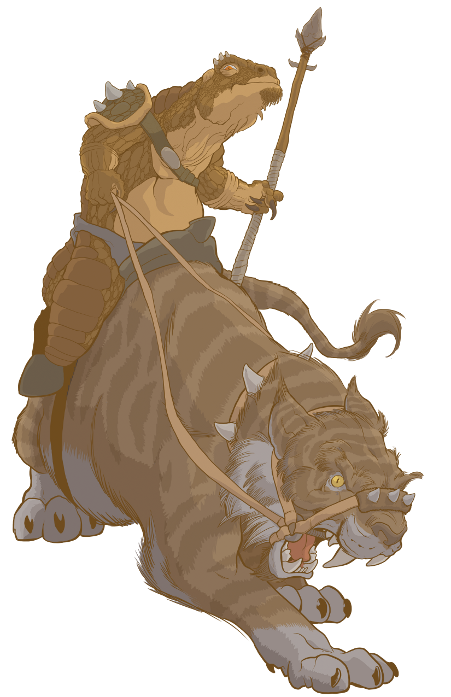
The Reptile Men are an off-brand version of the Simvan Monster Riders of Rifts fame. Stat wise they’re stronger but dumber than humans, and with less Charm. Prior to entering Earth they were from a Bronze Age society of herders and raiders that made their living riding giant cats rather than horses. After coming to Breachworld, very little has changed other than an increase in their raiding activities over their herding. That’s probably a result of their fascination with technology. Using the guns and armor liberated from the cultures encountered on Breachworld, they’ve become a real threat to shipping and transportation all throughout the campaign area.
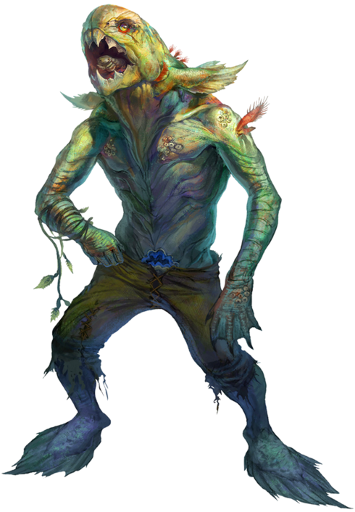
River Folk look like a cross between the creature from the black lagoon and a coelacanth. They may look like it, but they’re not really fishmen; they breathe air and can hold it for quite awhile but they have no gills and aren’t amphibious. Statwise they’re weaker and less coordinated than people, but are more charming. I’m not sure the intent there. Perhaps they’re just meant to have a reserve of willpower, but I can’t help seeing it as social grace and genteel charm. You know, that endless charm you accrue from farming mud alongside rivers.
Mostly they pursue agriculture alongside rivers and other bodies of water that can keep their skin moist. They actually seem pretty boring compared to other famous fish races.
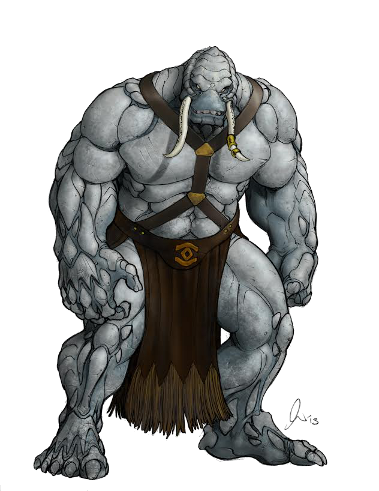
The last race included in this book is the Tusk , who are a sort of elephant-man. They’re large, incredibly strong, slow witted, slow in reactions, totally without charm, and have natural armor in their rhino-like skin. Basically they’re your standard large, melee oriented race comparable to Rifts races such as the Seljuk, Tautons, or Brodkil. On Breachworld people tend to put them to work as bodyguards, enforcers, or mercenaries. Anything that will put their intimidating size and strength to good use.
Few of them have come through the breaches, and those that did have been on Earth long enough to culturally forget their own homeworld. Legends paint them as some of the smallest beings on their world, but nothing concrete can be said since few to no Tusks have been there.
Overall, it seems like an okay spread of races. Some seem unusually specific for a core book, such as the Climbers and River Folk. The Holy are also fairly specialized but I can forgive them for it. Most races cover broad archetypes that people will want to play. I appreciate the fact that anything comparable to alignment or the idea that a race can be simply good or evil is ignored. I always hated looking at Rifts races and seeing the ones that are obviously only intended to be NPC enemies since there was no way they were going to function normally in society. The simplistic naming conventions don't really do it for me. I would have preferred something more flavorful for racial names, but that's a pretty simple fix.
Next will be a very, very brief recap of the rules.
The Rules
Original SA post
Breachworld Part 4
The Rules
As mentioned before, the game uses the MiniSix engine, which is a stripped down and modernized version of the old West End Games D6 system. I have no real experience with the new, systemless versions of D6 and can’t really comment on the similarity or differences, but you can get the general rules that power this game here for free . Everything I note about this system is entirely in theory since I haven’t yet played this game and I haven’t played a D6 game in 20 years.
The basic concept is to roll a number of six sided dice depending on your stats, skills, and any applicable modifiers, add up the total and compare it against a target number. Combat is a major part of the game and a major part of the rules. You have several derived statistics that apply only to combat, such as your static Dodge score that opponents must beat to hit you or your Soak score which is a number subtracted from any damage you take.
You have Fate points, which are the same idea as Hero points or Feat points or any of a million other RPG conceits to your unusual status. They can add 6 to any roll, reduce the severity of damage, or provide less defined benefits if the GM is feeling generous.
That’s basically the core of the rules and all the rest of the chapter is spent covering contingencies such as healing or experience or vehicles. They cram enough rules to play the game successfully into 11 pages including a fair amount of art. I used to think of D6 as a rules medium game which might have been considered rules light when it came out during the 1980s. After looking through the rules here, though, I would say it definitely falls on the heavier end of rules light. I think it would make for an easy time converting in all your Rifts campaign material if that weren’t so strenuously forbidden by Palladium.
There are a couple of things worth mentioning before moving on to the subsystems. The scale system that’s been a part of the D6 game since the beginning seems like a real boon to a Rifts game. One of the most obnoxious and lamentable parts of Rifts was how it totally fell apart just above the basic human level. You had monsters or vehicles with hundreds to hundreds of thousands of MDC that could only do tens to hundreds of MDC per round in damage. If one took the rules as gospel, fights between these things would take hours or days. The D6 system uses a method of scale to keep the numbers reasonable between adversaries of the same size. There are six degrees of scale ranging from human size to Star Destroyer/Planetoid size.
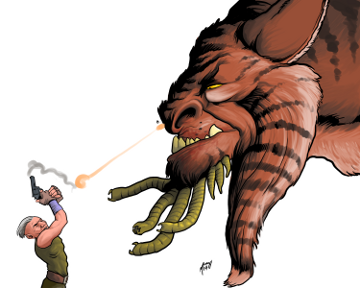
As an example, if something on the scale of a Plasma Wyrm (the weird enemy monster on the cover) is blowing flame at another Plasma Wyrm, it does 9D damage, which compares reasonably with its soak of 21. The numbers make sense even. If it shoots flame at a human, though, it gets a flat bonus of 6D damage due to it being three scale sizes larger, and if the human shoots back the Wyrm soaks with 18 added to its base score. Human scale pistols and rifles obviously aren't going to cut it.
If a GM is careful they could easily incorporate these ideas without needing the scale system, but the real benefit is to coming up with things on the fly. With the scale system, you know instantly that something with a soak score of 21 is tough. That applies to anything and you don’t necessarily need to modify it to make it work just because it’s a 30 foot tall monster that’s tough for his size rather than a street thug. Using a soak score of 39 for the giant monster might be a bit harder to pull out of thin air without guidance.
The other part I like is the wound system. Rather than having an ablative pool of hit points or MDC or whatever, you have damage leading to individual wounds once they get past the soak score. If it just barely beat the soak you are just dazed and suffer a penalty to skill rolls for a turn before it’s shrugged off. If it beats the soak by a lot, you might take a wound which can become a severe wound if you get another. More than that and you can be instantly incapacitated or even vaporized. I always thought a lot of the Harn damage method of individual wounds, but the system as a whole was unwieldy. I think the MiniSix wound system is a decent playable alternative that thinks along the same lines.
The Aether Feats (re: spells) are included in the rules. There’s really only one interesting thing about them – since there are no levels in this game, there is no technical reason you can’t buy the largest, most potent feats at character creation. They require a roll against a target number to activate, though. The more powerful the feat, the higher the target number, so most of the high level feats are realistically beyond the reach of beginning characters. On the other hand, if you want to buy a high level feat that it unlikely to activate but keep it in your back pocket for emergency situations (where it can likely be activated using Fate points) then that’s an option as well. It sort of plays like L5R 1e’s magic system, which I consider a positive thing.
Vehicle rules are a significant part of the chapter but are not interesting and not really worth a recap. The chapter ends with optional rules such an encumbrance or a system of graded successes. I guess I could see encumbrance being useful if this was a hardcore survival post apocalypse game rather than a gonzo one. It’s not, though, and I can’t imagine ever using it.
Overall the rules are a lot more involved during the process of making a character than they are when you actually play. Making a character could take ten minutes to a half hour or so at the outside, but I can’t see a lot of hiccups to slow down play once you have that all on paper. I think it’s a decent balance to strike for something aping Rifts. There’s enough granularity to keep your weird aliens and weird backgrounds from feeling too same-y, but the differences shouldn’t end up breaking the game. Until someone makes a FATE conversion for Rifts, I think this is about the lightest rules system we’re going to see.
Up next we finally get into some detail about the setting.
History Leading to Breachworld
Original SA post
Breachworld Part 5
History Leading to Breachworld
History Leading to Breachworld
We finally get into a more detailed description of the world and its history beginning about 130 pages in. The key to the whole setting is the breaches, and that’s where the bulk of the history is focused. Beginning in 2012, scientists discovered gates, which was a piece of technology consisting of two devices at different locations that could transport materials between them instantaneously. It appears to have worked like Portals from the Valve game: you could see the other side and walk through instantaneously. The theoretical physics behind how the gates operated was not fully understood, but testing showed that it was safe and within three years major governments began to create gate centers where travel between distant parts of the globe became as simple as walking down the block.
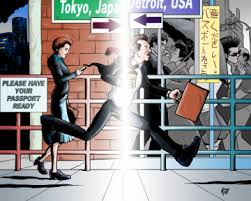
Within a decade gates had become the primary method of shipping and travel, and other modes of transportation slowly began to atrophy. Initially gate travel was heavily regulated since there was still a fair dose of skepticism from the general public. By 2040 the perfect record of safety had won the people over and gate travel was deregulated by most governments. Gate travel was as deeply enmeshed into the fabric of society as possible. Communications were faster, shipping was cheaper, and a person could become a world traveler without ever having to drive or fly. Walking uninterrupted between the major cities of the earth without ever leaving the comforts of society was a simple possibility. Technology boomed as scientists were able to consolidate their efforts and experiment with miniaturized gate technology. Advances such as fusion reactors became a possibility using well placed, miniature gates.
By the 2060s, old concerns about the safety of the gates began to resurface as odd anomalies began to occur. At first a handful of travelers on tight schedules noticed that they arrived seconds or minutes later than instantaneous travel should have allowed. Then it became hours. As the errors continued, sometimes a traveler would emerge from the wrong gate location with no explanation as to why or how. It was still a vanishingly small percentage of all travelers, but the percentage was growing. Scientists petitioned the governments for reform and more funding to understand the gates. The gates had become too much a part of the world to shut down altogether, and they kept in use even after the first confirmed case of a traveler disappearing into a gate and never returning.
In 2066 all gates around the world suddenly changed. Instead of linking two distant points, they now allowed one way travel from what appeared to be other dimensions into our own. Alien species of flora and fauna emerged from the thousands of gates, now called breaches, across the world. Since the primary concentration of breaches was in the cities with the most people, millions died in the first few days. It was a total societal collapse. The breaches were too numerous and dangerous to fully contain and governments collapsed while trying.
According to the future historians, likely hundreds of years have passed since that day. No one knows exactly how long the breaches have been active thanks to the total collapse of record keeping in the decades following the apocalypse. It seems pretty unlikely that so many years could pass and still leave Breachworld with buildings or working technology. They don’t even have the old Rifts standby about MDC building materials keeping things in working order. In my own campaign, I would just assume it’s more a matter of decades to maybe a century.
The Breaches
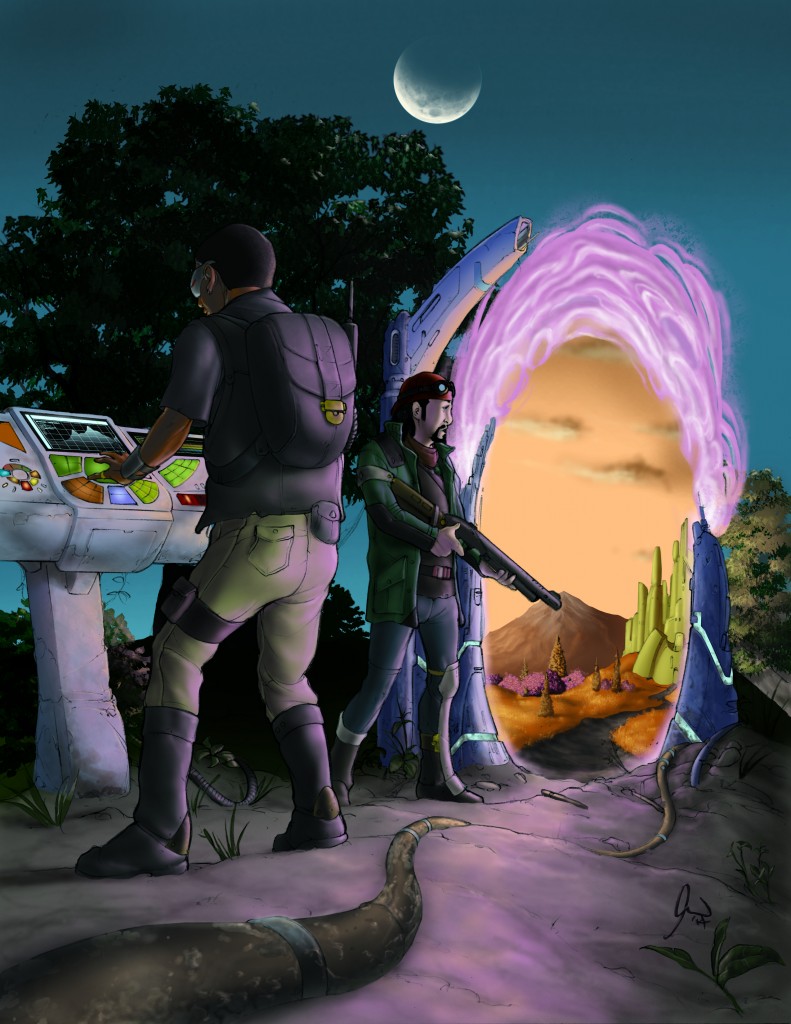
Now for a discussion of the breaches themselves. The breaches appear like a portal or doorway into another dimension. A person earthside is able to see clearly into whatever dimension the breach leads in from. That’s because it is a two dimensional tear in the fabric of space that allows matter and energy to come through to earth. Matter and energy cannot go out, though. If a person standing earthside tries to enter into the other dimension they can see they will pass through the breach like a hologram and remain solidly on earth. There is no resistance and nothing happens to the earthling.
Just outside of the breach is what is called a “Hot Zone” where alien organisms of all sorts congregate and tend to spell danger to unwary travelers. I imagine the larger hot zones, in places where there used to be collections of gates, would be a chaotic mess of competing ecologies. It brings to mind the
The War Against the Chtorr
more than the world of Rifts.
Another quirk of the breaches is that some are a spigot for a substance known as Aether, which is an energy or matter that scientists believe is one of the building blocks of the universe. In practical terms, it allows for magical effects that were not possible before the opening of the breaches. Since the book seems to like to veer more toward harder scifi explanations for soft scifi tropes, I would link the Aether with the Oz Particles of GURPS Technomancer fame.
No one knows what an alien staring through the breach into earth actually sees because there is no way to contact them until they step through, and most probably don’t want to talk about it once they’ve become hopelessly trapped on earth. Once an alien does come through the breach, they have the same experience with the breaches as do earthlings. They can stare longingly at their own dimension, but they can never return.
I can understand from a thematic standpoint why the breaches operate this way. It helps keep the campaign world grounded and shifts the focus away from gonzo dimensional travel a la Phase World. It even keeps Earth from becoming a valuable dimensional nexus like Sigil or Cynosure. Earth is just a dimensional fly trap and the concerns of things beyond earth are essentially academic.
The issue I see is with the mechanism of the breaches themselves. Once things go through the breach, they cannot travel back and there is therefore no pressure from the destination world. Basically, to the other side of the breach, the opening leads to a place of zero pressure. It might as well be an opening into deep space. The atmosphere from other worlds would come pouring into the breaches with hurricane force. If we assume that there were at least 5,000 breaches active when the apocalypse occurred (which seems like a gross underestimate), and if we assume that the average atmospheric pressure on other worlds is around the same as earth’s, then sometime in the intervening hundreds of years the quantity of gases in our atmosphere would have more than doubled. The atmospheric pressure would begin wiping out living things on earth, particularly large fauna. The ecosystem would collapse due to the influx of new gases. More slowly, all of the worlds connected to Earth by the breaches would have their atmospheres drained. It may take thousands of years, of course, but it would essentially be inevitable.
It’s pretty easy to handwave this sort of issue away. We may as well just assume that only solid matter has enough mass to make it through the breach or something to that effect. I just highlighted it because it strikes me as a very old school sort of RPG problem. By trying hard to apply ‘realistic’ mechanisms to something that may as well be magic, all hell breaks loose.
The Breachworld
We finally move into the setting proper. Honestly, there isn’t a whole lot of information given considering the potential. I am going to chalk this up to this being the first book and the stated intent to keep the scale of conflicts more local.
The place you plop your characters down in turns out to be a slice of Texas bounded by San Antonio in the southwest, Houston in the Southeast and Dallas in the north. Of course none of these places are named outright, except perhaps Fort Hood, which is known only as Hood in the ruins of America. I am not an expert in Texas geography, so I could be way off base on the things I’m telling you. I got most of my information from Google Earth.
There are several active groups in the area that are worth a mention. The largest and potentially the most powerful are The Resistance, which are our pro-human Coalition stand-in. Unlike the Coalition, they aren’t a nation proper but more of a loose terrorist organization. They generally operate in a cell structure in places with large non-human populations, and act as a regular political organization where they are able to show their face. Some towns, such as the aforementioned Hood, are controlled by The Resistance in all but name and nonhuman visitors are rarely welcome. The idea of rounding up a posse of Resistance members to hang or run nonhumans out of a city is kind of a problematic image, honestly, and I think I would end up altering them to take the edge off.
The Cooperative is a white-hat organization of scientists and adventurers who work to reclaim the technology of the Golden Age, and thereby bring back the standard of living earthlings once enjoyed. Their most recent advance is the BCD, or Breach Closure Device, which is the first time anyone has been able to close a breach since they were opened. Like The Resistance, they’re not a standard government but a loose organization of like-minded folks. They’ve begun to create BRACS, or Breach Research and Closure Squads. Yup, that’s pretty much what your party will probably end up doing. They don’t have the money to fund major operations, though, so you’ll be mostly on your own. Ironically, they appear to be doing the exact work the Resistance would like done even if their intent is totally different.
Rose Armaments is our Breachworld version of Northern Gun or Naruni Enterprises. Caravans of Rose Armaments traders come through regularly and sell of oodles of high tech weaponry for reasonable prices. No one is sure where their home base is, if they are manufacturing their own weapons, or if they are simply selling off an ancient cache found in some ruin.
Rumors of far off lands sound more like medieval legends than fact. There is talk of a town of pre-Armageddon people who never seem to age. Others talk about forests where dinosaurs run wild. A common rumor is of a man in the ruins of San Antonio who can bring the dead back to life for a suspiciously low cost. Basically there’s room for any rumor you want the players to hear.
Society exists mostly in the form of small farming communities or small city-states. Technology is incredibly variable since a surviving factory or power plant may be enough to raise the local technological level. Usually something significant surviving from the Golden Age is enough to found a city state or regional power around. On the whole, however, people are working at a barely pre-industrial level and farming is the main occupation. It’s not the only occupation, though. There is opportunity to be had combing through ancient ruins looking for functional technology or any books that might make life easier. Raiding is another choice occupation and helps make the world seem smaller by limiting the reliability of travel and communication.
The economy has resorted to trade rather than currency. There are simply too many cultures and too many political ideas floating around to agree on a single type of currency. Some of the largest communities have something approaching minted money, but it’s far from a universal, accepted currency. Cattle and horses tend to be the most valuable items commonly traded. Weapons, particularly Golden Age weaponry, are not often traded due to their rarity and potential value. Vehicles do tend to see some trade among raiders and mercenaries, although finding something that can still drive is incredibly rare. Most people just use horses.
Now for some of the locations in PA Texas. Really only two major and one minor location are outlined, although quite a few more are shown on the map.
I mentioned Hood a couple of times. It’s a town in the ruins of Fort Hood that is totally run by human supremacists. They act in basically the same way as the Spartans: the citizens of the town are soldiers, and everyone else is doing manual labor for them under the threat of violence. There is quite a bit of breach activity in the area near Hood, but a disciplined military and lots of functional weaponry make sure it’s not a real problem. According to the book, exactly 522 humans live there.
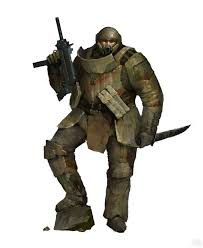
The Arena is a community created out of the ruins of Floyd Casey Stadium, home of the Baylor Bears. In the future it’s turned into a community of mostly humans with some Minotaurs and Machine Men thrown in for good measure. There are solid enough walls to be defensible, an area for protected agriculture where the field used to be, and enough housing in the stands area to handle hundreds. Over hundreds of years of slapping habitation together, it looks less like a football stadium and more like a city in miniature. There is plenty of breach activity in the area to keep the defenders busy.
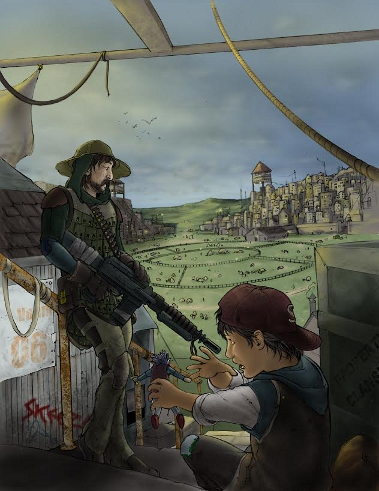
One trading post is outlined, and it’s located along the ruins of Interstate 45 somewhere north of Centerville. It is staffed by a single Grim trader. At any given time, dozens of travelers from all over the area can be found stopped here on their way around the wasteland.
Other than an appendix of monsters that I will discuss next time, that’s all the information we get on the setting. It feels a lot like something I would have came up with if I lived in Texas. Not being from Texas, though, it feels kind of strange. If I were to play this game, I would probably choose to set it somewhere more familiar to my players since the limited setting information is probably not enough to overcome their unfamiliarity.
Part 6
Original SA post Breachworld Part 6
Hey, how about I quickly close out an RPG I had one more update to finish just over three years ago and inexplicably failed to complete? That 'abandoned' note in the inklesspen archive is haunting me. Back to Breachworld!
In the intervening three years, quite a bit has happened that feels relevant to this review. If you don’t remember, Breachworld was an RPG that basically acted as a knockoff Rifts using a much more coherent, rules-medium system called Mini Six. At the time it had a very useful niche to fill since so many people have a fondness for Rifts that absolutely does not extend to the Palladium rules system. Since my last update Savage Rifts was announced, successfully Kickstarted, and successfully delivered to backers. It uses the Savage World system and is comparable to Mini Six in rules complexity. I would never have guessed that Siembieda would ever allow this in early 2015, but here we are. It makes for an interesting comparison to this project.
Additionally, Jason Richards, the author of Breachworld, has successfully kickstarted a run of miniatures for this RPG. I thought it was strange since I don’t imagine there is a great need for miniatures for a small press RPG, but they look good in concept at least. It’s not really relevant to the review but I hope this at least means he is continuing to find success.
I will have more comment on it in the afterword, but for now I should mention that I have gotten to play another game using the D6 rules a couple of years ago (Star Wars) and a single session of a Savage Worlds spy game. I generally think the Mini Six system is a better choice for supporting the playstyle of Rifts than Savage Worlds normally manages, but I also think that Savage Rifts was a well enough designed product to alleviate this disadvantage.
Breach Creatures
There is only one main section left to the book and it’s the obligatory bestiary. The section is called Breach Creatures because it doesn’t include any human or humanoid opponents. That’s a pet peeve of mine – I tend to use more human enemies than huge monsters simply because having people around allows for a lot more complex motivations. Not a big deal, though, since it tells you what it is right up front.
First we get some classic dinosaurs and are given stats for an Allosaurus and Tyrannosaurus. No complaints. Everyone knows that dinosaurs are a solid Rifts enemy.
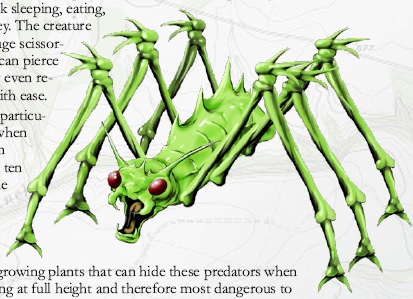
Next we have the Creep, which is a larger-than-dog-sized bug that acts as a sloth-like ambush predator. No, I don’t mean sloths are ambush predators, but that the Creeps are described as moving so slow that they aren’t detected by normal vision and give electronic surveillance a run for its money. They look pretty scary, but I am imagining a sloth trying to adorably reach down and slooooowly snare a person and it’s hilarious.
A standard griffin is included, which seems like a good choice for utility but not all that interesting. More interesting is the Hardhat, which is just a new name for some variety of extinct rhinoceros with a truncated horn. It’s just a big, smashy changing monster with nothing else to do.
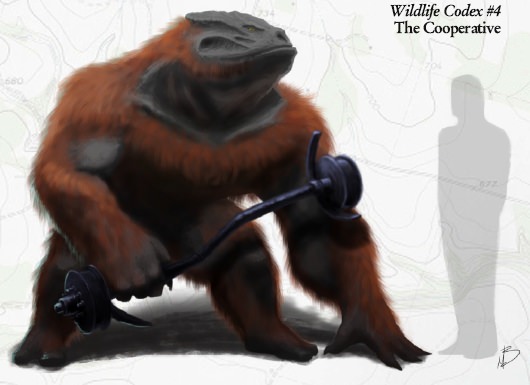
Hoodlums are a sci-fi stand in for a gorilla, but are larger than any earth gorilla. Weirdly the entry goes into how they sense vibrations to signal amorous intent, and how they bang on steel objects so that their intent can be heard miles away. It’s certainly an interesting tidbit. Other than that it might as well be a gorilla or Neanderthal or any other humanoid bruiser that’s just below the ability to communicate.
Imps are small demons that once again seem a lot like what you might expect. They’re roughly a foot tall and mess around with people’s lives through sabotage and trickery. I’m never sure how I would use something like this in a game (for another example, see mujina in L5R) but these kinds of enemies do show up a lot.
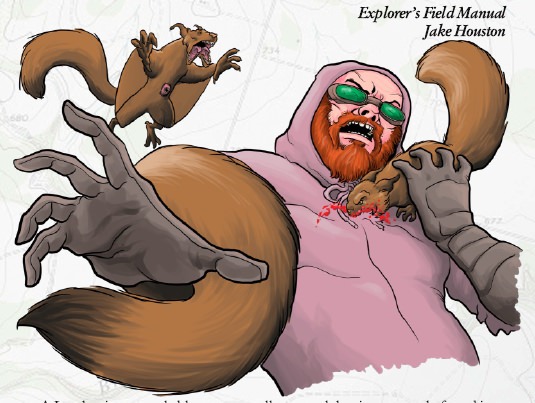
Leechers are an innovative enemy: flying squirrels with a huge mouth full of sharp teeth to tear their prey open, and then suck blood from the wound using a second mouth located on their stomach. I dunno where that came from.
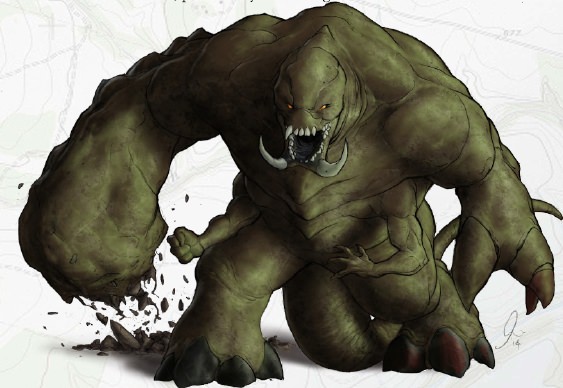
The mauler is another big, mostly humanoid bruiser, but much larger and more dangerous than the Hoodlum. It has four arms – two huge arms for smashing things and two smaller arms for fine manipulation. I could see a fair amount of use for it as a set piece enemy.
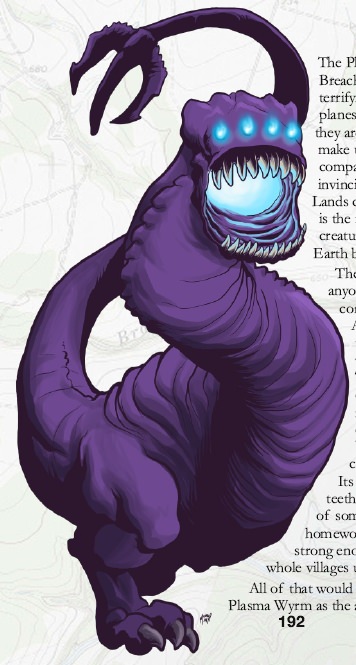
Speaking of set piece enemies, we finally get to the Plasma Wyrm, otherwise known as the creature on the cover. Boy, it's a big, weird looking dingus. It’s an endboss type enemy with 6D scale, very high stats, and a base plasma attack of 9D. It will vaporize most encounters like a dragon-thing should. Luckily they are as rare as can be and only a handful are known. They tend to stay in their own territory and the best bet is to avoid them unless you go in with a good plan and a lot of firepower.
A poison bat is an oversized version of a standard vampire bat than is also poisonous. It’s got a wingspan of 10 feet and injects poison through a long, proboscis-like tongue.
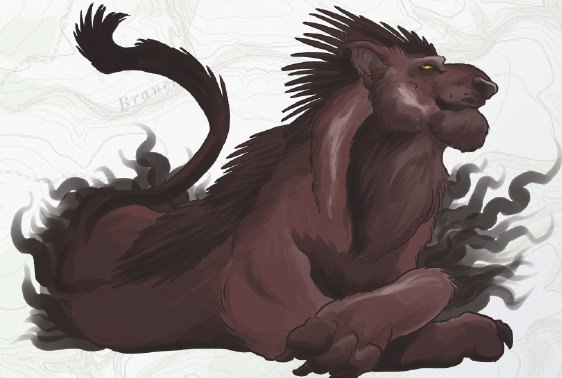
This smug looking motherfucker is a prowler beast. A prowler beast reminds me of an upscaled displacer beast. It’s based on a large cat but is actually larger than a lion. It exudes a dark mist that cloaks itself and gives it enhanced ability to sneak at night. If you manage to kill and skin one, the clothes you make from its hide give the wearer a bonus to stealth rolls.
Trapcats are another large feline enemy but their claim to fame is that they are used as mounts by Reptilian Raiders. It looks very much like something out of He-Man. They’re natural hunters and move very quickly. There’s isn’t much else to recommend them.
That’s it. It’s a strange smattering of creatures from the broadly useful (dinorsaurs, big bruisers) to the somewhat specific (vampire bats and ambush cats) to the fucking weird (those squirrels). I’d say it needed to be fleshed out with more standard fantasy or scifi enemies to be truly useful. It suspect the intent was to utilize Mini Six bestiaries completed elsewhere, though.
The last part of the book includes useful game aids such as character sheets and all of the tables that might be useful in a GM screen. I’d like to note that the author has continued to put out new races as mini-expansions on DriveThruRPG and has done more to support this game that I would have guessed when it was on kickstarter. Other than that we’re now done with the book.
Afterword
Back to thoughts on Savage Worlds and the comparison to this game. I mentioned that I felt Mini Six is an overall better fit for Rifts style play than Savage Worlds. Let me expand on that.
I admittedly have fairly limited experience with Savage Worlds as a ruleset, so take everything I say with a grain of salt. I generally feel that Savage Worlds characters generally do a better job of being wide than deep. The base rules seem to lean toward characters that are fairly competent in a lot of ways and not necessarily extremely powerful in specific ways. A character with d10 or d12 in a combat skill is going to be very competent compared to someone with a d4 or d6 combat skill, but thanks to the wild die things could easily swing away from the better combatant. Additionally, Savage Worlds characters tend to be more fragile and a lucky shot could still end this fight early. Now my blind spot is that I really haven’t used the super hero rules which likely address this weakness and leave everything I’m saying in the dust.
Mini Six and D6 games in general seem to have a slightly larger spread of power built into the system itself. A character with a 6d Might is going to be so much better in melee combat than someone with 2d that we’re not operating on the same level. A hand to hand fight would be a one sided affair to the point that I’d barely consider it worth running through without a large disadvantage placed on the 6d character. It might not seem like a positive thing in most games but it certainly fits the Rifts source material better. I also think the scale system for adding dice to a creature or vehicle is a pretty quick and handy way to adjust the scale of combat on the fly without having to re-stat things. I haven’t seen something similar in Savage Worlds, but that could be my inexperience talking.
For better or for worse, Rifts is a game that tends to have very distinct power levels between different characters. Going back to the original Palladium system, one player could make a Vagabond and another an optimized demigod that can cast any magic, has ludicrous combat capability, and a minimum of hundreds of MDC. The only disadvantage is that the demigod would take maybe twice the experience to level than the vagabond, and that’s not much of a problem since a 15th level vagabond will still be orders of magnitude less powerful than a first level demigod.
I don’t think anyone is looking to reproduce discrepancies of this magnitude. To get the ‘feel’ of Rifts, though, some level is probably necessary. Back to Savage Rifts. They actually do manage to reconfigure Savage Worlds to emulate Rifts fairly well, and they do it by making the classless Savage Worlds system into something roughly class based. It appears to work very well. A young dragon or a full conversion cyborg will have access to more raw power right off the bat than a MARS character, but they MARS character will have access to a better spread of skills and equipment. It just seems to work more slickly than Palladium ever did. It’s the fulfilled promise of the idea that the original Palladium system intended – different characters will be able to fill different roles and different power levels will actually be able to contribute more or less equally. I haven’t played it, though, so I could be way off base.
I would have liked to see what might have been done with a similarly well thought out revision of the D6 system. I have been following the progress of Mythic D6 through rpg.net threads and it looks very promising as a super powered take on the classic D6 system. I’d guess that less tinkering would be necessary to make D6 into something that hits the right notes for Rifts than was needed for Savage Worlds.
That said, I do think that Breachworld is now a product without a market. I will always contend that the selling point was a version of Rifts that isn’t tied to the abominable Palladium system. That’s what I backed it for. Unfortunately for Breachworld, there is now an official product filling this same role. I don’t feel that my own preference for Mini Six would be enough to spend the time porting over everything I needed when Savage Rifts has already done the work for me.
And we’re done.